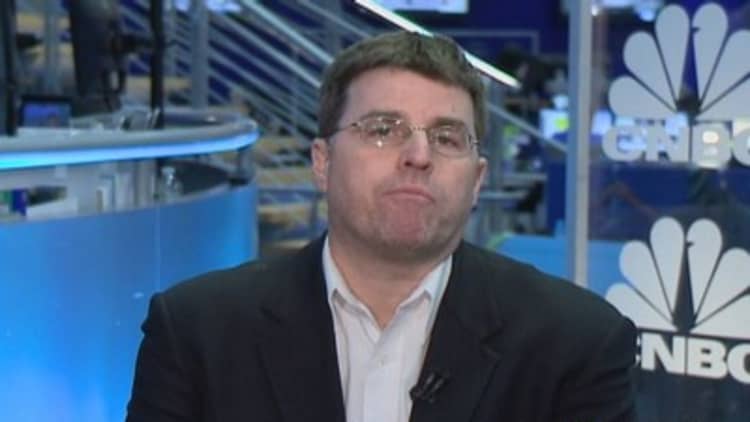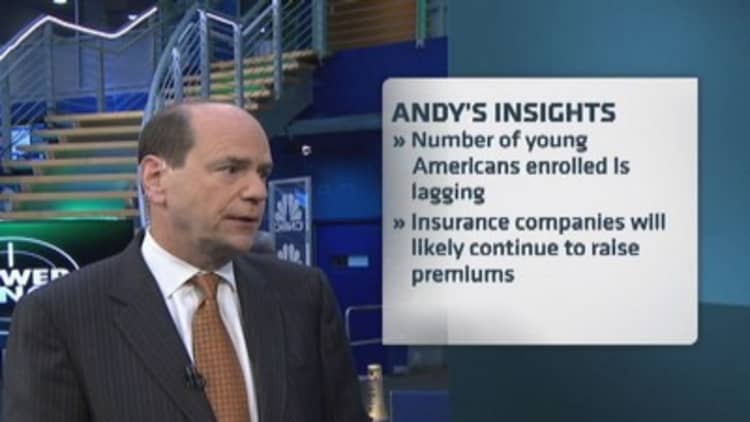
Obamacare's most controversial feature—the requirement that nearly all Americans have health coverage this year or pay a fine—may not have been a big motivator for the more than 7 million people who signed up for new insurance plans, several analysts said a week after the close of open enrollment.
And even if Obamacare's so-called individual mandate spurred a solid chunk of those enrollments, the law's true power will be really felt in coming years, when the penalty escalates and many millions of people more are spurred to sign up because of financial concerns, those experts said.
"I don't think it was really a big driver" this year, said Matt Eyles, executive vice president of the Avalere Health consultancy, about the mandate. "I think it only had an impact on the margins."
"It was the carrot, not the stick," Eyles said, of what motivated people to enroll, noting that the Obama administration and Affordable Care Act advocates emphasized the new plans' benefits and not the penalties in their massive outreach efforts.
Eyles added, the mandate's financial hit to people who don't comply is "weak," and typically will cost less than the new insurance premiums they would have to pay to comply.
Under Obamacare, most people must have some kind of health-care coverage—through their employer, the individual insurance market, Medicare or Medicaid—by March 31 of this year or pay a tax penalty next year. That penalty is equal to $95 or 1 percent of a person's taxable income, whichever is higher.
To help people comply with the mandate, the ACA established government-run health exchanges to sell private insurance to individuals and families. Those exchanges saw a flood of more than 3 million people in just the last month of open enrollment, bringing total sign-ups to more than 7 million.
Read MoreStart-ups are making a killing off Obamacare
Christina LaMontagne, a health cost analyst for the price-comparison site NerdWallet, said that penalty "wasn't really that significant" in getting people to enroll, from what her company heard in interviews it did with people exploring their insurance options.
Instead, LaMontagne said, "We heard people saying they really valued health insurance ... we heard again, and again and again that people wanted health insurance, and they were sick of finding these short-term solutions."
"People have expressed a desire to be insured and have over time pieced together temporary solutions as their employment or health situations have changed," she said. "One common thread were heard from parents is that often some family members were insured while others were not. ... For these families, [the Affordable Care Act] offered an opportunity to get everyone covered in some way and to fill in gaps across the family unit."
And many of those people qualified for government subsidies to help them offset the cost of the insurance plans. Those subsidies are available to people who earn less than 400 percent of the federal poverty limit—about $46,000 for a single person and about $94,000 for a family of four.
Read MoreMedicaid enrollment up 3 million under Obamacare
"Those subsidies just changed the game," LaMontagne said, crediting them with being a significant motivating factor for enrollees. About 80 percent of enrollees on the exchanges qualified for the subsidies.
Another skeptic of the power of the mandate, Bankrate.com analyst Doug Whiteman, who noted that his company's surveys of the uninsured "found a very surprising lack of knowledge" about the ACA "just a couple of weeks" before the sign-up deadline. Only 48 percent, for example, could correctly identify the deadline, Whiteman said.

"I think it was very difficult to get the word out to uninsured people," Whiteman said.
"I think there is widespread misunderstanding about the penalty itself," he said, arguing that contributes to its lack of effectiveness in spurring enrollment.
In fact, tax preparation experts, including Brian Haile, who heads up Jackson Hewitt Tax Service's health care reform-related efforts, have said they frequently hear from clients that the penalty is just $95, when in fact the clients are likely to pay much more than that for failing to obtain insurance.
Read MoreFinal Obamacare deadline (for real!) is tax day
But Larry Levitt, senior vice president of the Kaiser Family Foundation, pointed out that 66 percent of the uninsured questioned in a KFF tracking survey in March had known there was a fine for failing to have health insurance. Levitt had no problem crediting the mandate with getting many enrollees to the exchanges.
"It's plausible to think that the mandate was the motivating factor" in the last-month surge of enrollments on the exchanges, Levitt said.
"The long lines of people in the last few days of March were probably an indication of the effect of the mandate on people's behavior," he said. "You wouldn't wait until the last minute if you really needed insurance, you wouldn't go without insurance until the last day."
Levitt also argued that the Obama administration, by not highlighting the penalty in its marketing efforts, could have missed an opportunity to boost enrollment even further.
"In this case, I think by highlighting the mandate all along they might have gotten more people," he said. However, he and other analysts noted that the administration had to weigh that tactic against the likely political backlash it would have spurred from Obamacare opponents.
"I wouldn't be surprised if they revisit [that idea] next year," Levitt said.
He and others interviewed for this article said that the increase in the penalty in coming years could be largely responsible for much higher enrollment on the exchanges. The penalty increases to the higher of $325 per individual or 2 percent of taxable income in 2015, and $695 per person or 2.5 percent of income in 2016. It gets adjusted for inflation thereafter.
"If you look at the [Congressional Budget Office's] projections of enrollment in the exchanges in the next couple of years, they assume it's going to ramp up very rapidly," Levitt said.
In its most recent estimates, issued in February, the CBO projected that enrollment on the exchanges would reach 13 million in 2015, and then hit 22 million in 2016. The CBO expects that enrollment will then reach 24 million in 2017, and a high of 25 million the following year.
—By CNBC's Dan Mangan


